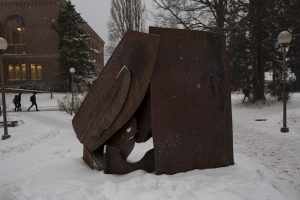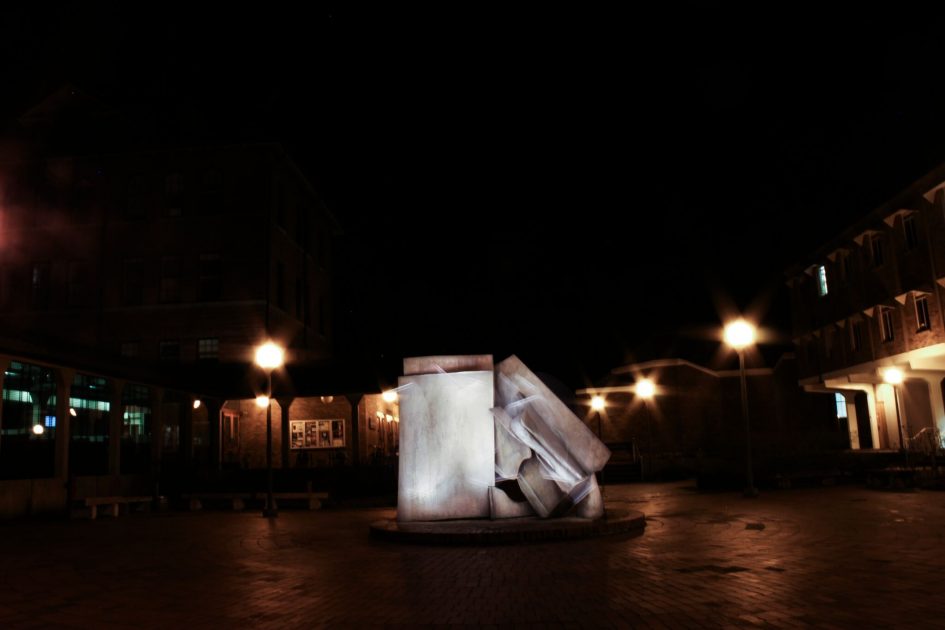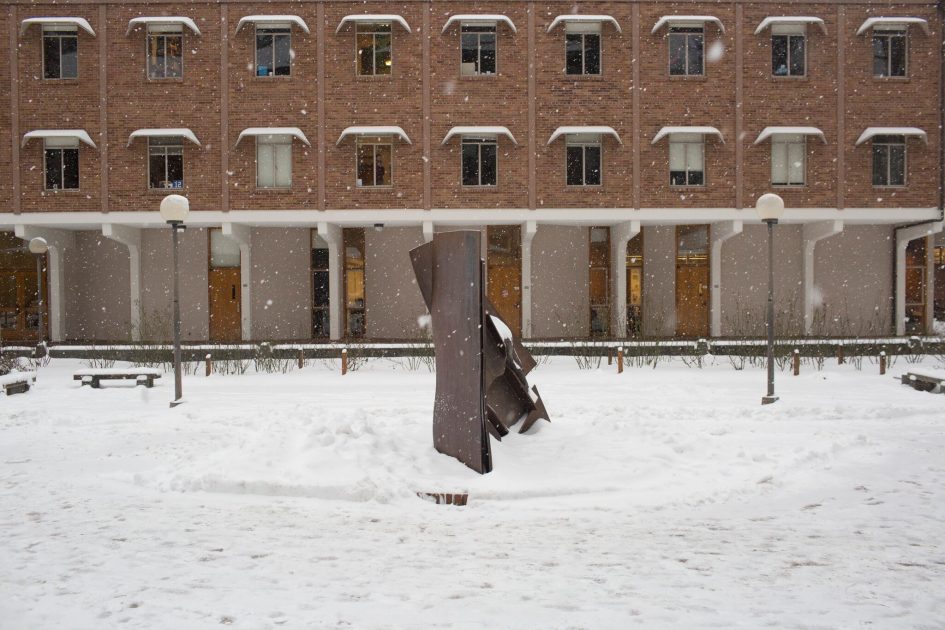 As you step out of Old Main, surely you will notice the rusted, stained sculpture standing proud in the middle of the area. Situated facing the bay with the arboretum behind it and enclosed on the other sides by Old Main and the Humanities Building, it certainly makes fine use of the space. The piece itself consists of three large rusty metal sheets that are self-supported and leaned on each other with smaller more textured pieces added on it. This creates a juxtaposition that makes the piece complicated and uncomplicated with the simple, blank, and minimalist styled left side and the asymmetrical, layered, and slightly chaotic tilting shapes of the right side. While you can tell that India was a product of a different era, it has a certain timeless aspect that exceeds it. This relationship the sculpture has with past is its best quality; the 1970’s influence reminds us of a time that once was, while the strong shapes keep a modern and progressive style. To create such a harmony with such jagged and seemingly unaesthetic elements speaks volumes about the talent of the artist, Anthony Caro.
As you step out of Old Main, surely you will notice the rusted, stained sculpture standing proud in the middle of the area. Situated facing the bay with the arboretum behind it and enclosed on the other sides by Old Main and the Humanities Building, it certainly makes fine use of the space. The piece itself consists of three large rusty metal sheets that are self-supported and leaned on each other with smaller more textured pieces added on it. This creates a juxtaposition that makes the piece complicated and uncomplicated with the simple, blank, and minimalist styled left side and the asymmetrical, layered, and slightly chaotic tilting shapes of the right side. While you can tell that India was a product of a different era, it has a certain timeless aspect that exceeds it. This relationship the sculpture has with past is its best quality; the 1970’s influence reminds us of a time that once was, while the strong shapes keep a modern and progressive style. To create such a harmony with such jagged and seemingly unaesthetic elements speaks volumes about the talent of the artist, Anthony Caro.
 Anthony Caro is considered to be one of the pioneering sculpture artists of his time, born in the United Kingdom in 1924, a visit to the United States in 1954 began his interest in working with steel. Caro’s sculptures are usually self-supporting and sit directly on the floor. In doing so, they remove a barrier between the work and the viewer, who is invited to approach and interact with the sculpture from all sides. Caro always prefers a
Anthony Caro is considered to be one of the pioneering sculpture artists of his time, born in the United Kingdom in 1924, a visit to the United States in 1954 began his interest in working with steel. Caro’s sculptures are usually self-supporting and sit directly on the floor. In doing so, they remove a barrier between the work and the viewer, who is invited to approach and interact with the sculpture from all sides. Caro always prefers a
human scale, as in a reflection of the human body. He is not interested in a sculpture reflecting near building but he is interesting in using architecture to inspire his work. Caro has had various influences ranging from other artists like sculptor avid Smith and from the different eras he had worked during.
During the 1970’s when  creating India, he was interested in monumental type sculptures and began using cranes and steel yards to create his work. The sculpture was created in 1976 and its modern style influence of the 1970’s is undeniable with the rusted vertical and tilting large sheets of steel. Interestingly, Caro did not actually visit the Western Washington University campus when he created the work which caused a bit of backlash as people criticized if he would be able to make a piece that best fit the space. Luckily the piece fit the space remarkably well and worked with the surrounding area. India still currently stands tall in the rose garden between Old Main and the Humanities building on the WWU campus and has aged quite well given its rusty surface. Anthony Caro’s abstract works were innovative at the time of their creation in the 1970’s and stands just as strong in 2017, the form of the shape transcends decades smoothly and the material of the sculpture often used in the industrial 70’s is also prevalent today.
creating India, he was interested in monumental type sculptures and began using cranes and steel yards to create his work. The sculpture was created in 1976 and its modern style influence of the 1970’s is undeniable with the rusted vertical and tilting large sheets of steel. Interestingly, Caro did not actually visit the Western Washington University campus when he created the work which caused a bit of backlash as people criticized if he would be able to make a piece that best fit the space. Luckily the piece fit the space remarkably well and worked with the surrounding area. India still currently stands tall in the rose garden between Old Main and the Humanities building on the WWU campus and has aged quite well given its rusty surface. Anthony Caro’s abstract works were innovative at the time of their creation in the 1970’s and stands just as strong in 2017, the form of the shape transcends decades smoothly and the material of the sculpture often used in the industrial 70’s is also prevalent today.
Works Cited:
-
Clark-Langager, Sarah A. Sculpture in Place: A Campus as Site. Bellingham: Western Washington U, 2002. Print.
-
Stearns-Phillips, Daydre. Western’s Outdoor Museum. Bellingham: Western Washington U, 1979. Print.
-
“Anthony Caro.” Wikipedia. Wikimedia Foundation, n.d. Web.
-
“Western Washington University.” WESTERN GALLERY. N.p., n.d. Web.



Leave a Reply